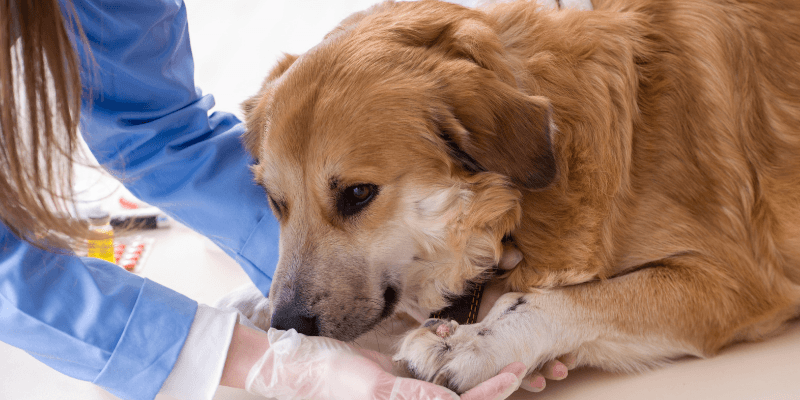When platelets count is too high in your dog, it can lead to many disorders that can cost their life. As a pet parent, it is crucial to understand what does it mean when platelets are high in dogs since it can lead to severe disorders and compromise your dog’s life in the worst way possible. For example, thrombocytosis occurs in dogs when the platelet count is too high, leading the blood circulating in your dog to clot incorrectly. It is a hematologic abnormality that can give rise to inflammatory, metabolic, and neoplastic abnormalities in your dog.
Do you have a specific question about the high levels of platelets in dogs? Then use the table of contents below to jump to the most relevant section. And you can always go back by clicking on the black arrow in the right bottom corner of the page. Also, please note that some of the links in this article may be affiliate links. For more details, check the Disclosure section at the bottom of the page.
Here's what we'll cover:
Thrombocytosis is indicated by a platelet count that is higher than 1,000,000/µL. Increased blood platelets can lead to abnormal blood circulation and clot formation in the bloodstream. If malformed clots land in your dog’s heart or lungs, it can lead to severe problems and even result in death, as it does in humans.
Symptoms of high platelet count on your dog
One of the biggest problems associated with diagnosing an illness in your dog is that they cannot speak about their discomfort to you. While we can complain about what feels wrong in our bodies when we feel uncomfortable, our dogs can’t do the same. As a pet parent, one of your biggest responsibilities is understanding your pet’s body and behavior at the base level. Any changes from what they usually are must be an indicator enough for you to seek immediate treatment.
Before getting to the bottom of what does it mean when platelets are high in dogs, it is important to understand the signs and symptoms of thrombocytosis in your dog. Unfortunately, these symptoms are rather vague at times, leading to further complications before you can even understand if something is wrong with your dog. Some of the most common symptoms associated with thrombocytosis include an enlarged spleen, blood in stool, distended abdomen, intolerance to exercise, activity loss, chronic anemia, fatigue, and weight loss.
What leads to thrombocytosis?
It is always important to understand the causal factors of a disorder as it can allow us to provide preventive measures if possible. When it comes to what does it mean when platelets are high in dogs, you must also understand what causes thrombocytosis in dogs. Thrombocytosis is most commonly associated with the release of the epinephrine hormone. This hormone is generally released into the bloodstream and responds to another disorder.
Thrombocytosis can also be related to and associated with bone marrow-related disorders. In many cases, thrombocytosis can actually be a temporary condition in response to a natural phenomenon like pregnancy or childbirth. However, it can reach a long-lasting stage when associated with inflammatory disorders or infection. Certain medicines increase platelet production, temporarily leading to thrombocytosis.
How is it treated?
The treatment procedure that is to be followed for thrombocytosis in a dog depends on what has caused this condition in the first place. The first step in the treatment procedure is actually to determine the causal factor of thrombocytosis or if there are other related disorders that need to be looked into.
For example, suppose a dog is suffering from cancer which has led to increased platelet production. In that case, the treatment will be focused on treating cancer first, which will automatically reduce the production of platelets in your dog. On the other hand, if this high platelet production is happening due to a particular medication, simply stopping it can help with thrombocytosis.

However, to dissolve the clots that have already formed, various medicines are anticoagulants in nature. These can be prescribed to decrease the platelet count and clotting. However, it is to be kept in mind that these medications have their own side effects. For example, if a dog is injured while taking an anticoagulant medication, it can lead to excessive blood loss.
Many times, supportive therapies are also administered to dogs suffering from thrombocytosis. This includes keeping your dog at the peak of their health by providing adequate and nutritious food and keeping them hydrated. This helps to boost their immune system as well as keep them healthy.
What happens when the platelet count is too low?
While you may now have a fair idea of what does it mean when platelets are high in dogs, it is also essential to understand what happens when the platelet count is too low. This can lead to a different complication which is called thrombocytopenia. While the symptoms of this disorder are quite different from that of thrombocytosis, thrombocytopenia can also be extremely dangerous for your dog.
It is important to keep the signs and symptoms of these disorders and mind when caring for your pet. Follow the vet’s advice very carefully to ensure a full recovery.
Thanks for the blog graphics: Canva.com

Thanks for the blog graphics: Canva.com
Doghint.com is a participant of several affiliate programs. The list includes (but not limited to) the following: VigLink, Refersion, ShareASale, and Amazon Services LLC Associates Program, an affiliate advertising program designed to provide a mean for us to earn fees by linking to Amazon.com and affiliated sites. Doghint.com does not intend to provide veterinary advice. All published articles are meant for informational purposes only and not substitute the professional veterinary consultation.


